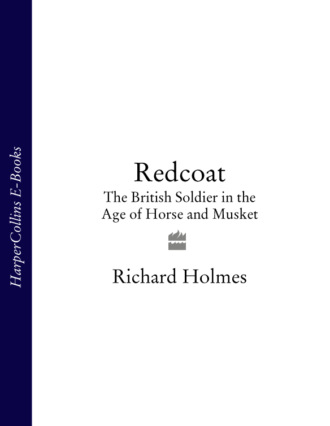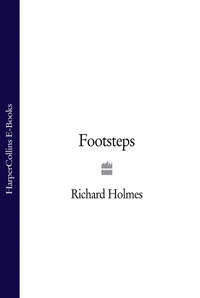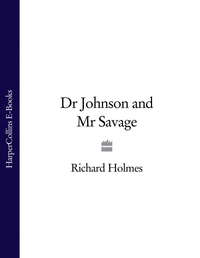
Полная версия
Redcoat: The British Soldier in the Age of Horse and Musket
This is a major reason for the British ambivalence about soldiers so well summed up by Rudyard Kipling in ‘Tommy’. It was often difficult to persuade the electorate that there was any real need for them. Sailors were another matter, for trade depended on secure sea-lanes, and sailors were, for so much of the time, out of sight and out of mind. Not so soldiers, who were an ever-present feature of Georgian and Victorian society. There were times when a sense of real and present danger swung the opinion of the public squarely behind its army. It is sometimes the apparently superficial that makes the point. During the American War, Georgiana, Duchess of Devonshire, threw herself with enthusiasm into helping her husband with the militia of Derbyshire, where he was lord lieutenant. She then raised a female auxiliary corps, and the Morning Post reported: ‘Her Grace the Duchess of Devonshire appears every day at the head of the beauteous Amazons on Coxheath, who are all dressed en militaire; in the regimentals that distinguish the several regiments in which their Lords etc., serve, and charms every beholder with their beauty and affability.’9 In 1795, with fears of French invasion rife, some fashionable Scots ladies turned out à l’Amazone in red coats with military cuffs and epaulettes, and Highland bonnets. English ladies took to velvet dresses of ‘rifle-green’ and the women of Neath petitioned the prime minister to be allowed to form their own home-defence regiment.
There are in this town about two hundred women who have been used to hard labour all the days of their lives, such as working in coalpits, on the high road, tilling the ground, etc. If you would grant us arms, that is light pikes…we do assure you that we could in a short time learn our exercise…I assure you we are not trifling with you, but serious in our proposal.10
The Prime Minister himself, Lord Addington, even appeared in Parliament in his militia uniform. Quasi-military dress again became popular during Napoleon’s hundred days in 1815, and one of Thackeray’s characters, dressed as a pseudo-officer to accompany the formidable Becky Sharpe to Brussels, hastily civilianises himself when he thinks the French have won. But all too often public opinion agreed with the mother of the future Field Marshal Sir William Robertson, who joined the army as a private soldier in 1877. She told her son that she would rather bury him than see him in a red coat.
The Royal Navy’s strength made large-scale invasion of Britain all but impossible – although, as we shall see shortly, it could not prevent the occasional French descent on Ireland. It enabled Britain to mount frequent amphibious operations. The first part of Thomas More Molyneux’s Conjunct Operations, published in 1759, reviewed 68 overseas operations since the days of Sir Walter Raleigh, seven of them great expeditions involving more than 4,000 men. Just over half had failed, and Molyneux devoted the second part of his book to telling his readers how such operations might be managed better in the future. He maintained that Britain’s geographical position, large navy and small army gave her a natural proclivity for operations like this, but also argued, as a veteran of Sir John Mordaunt’s ill-starred raid on Rochefort in 1757, that amphibious success demanded both specialised troops and equipment.
Amphibious operations were a feature of the age. Some were triumphant, like Wolfe’s attack on Quebec in 1759. James Wolfe had blockaded the Marquis de Montcalm in Quebec, but could see no way of achieving a decisive result before winter set in. He summoned his brigadiers to ask for their views, and they resolved on an amphibious attack on the Anse du Foulon, west of the city, where a narrow track led up to the Plains of Abraham. On the night of 12–13 September Captain McDonald, a French-speaking Scots officer, bluffed the French sentry on the track, and by dawn Wolfe’s ten battalions were drawn up on the plain. Montcalm’s men came on in three columns, and were met by an opening volley at a mere 40 yards, one of the most destructive in military history, which stopped them in their tracks. The British fired one more volley and charged, unaware that their youthful commander – he was only 32 – was dying. Montcalm, too, was mortally wounded, and Quebec surrendered on 18 September.
But some other amphibious operations were disastrous. In August 1809 a fleet of 235 armed vessels, 58 of them men-of-war, under Admiral Sir Richard Strachan, escorted 44,000 troops under Major General Lord Chatham to the low-lying malarial Dutch island of Walcheren. The expedition had two aims: first, to capture Antwerp, described by Napoleon as ‘a pistol pointed at the heart of England’, and second, to provide a diversion by an offensive on the Danube by Britain’s Austrian allies. Chatham’s army, stuck fast on the island, lost 218 men in action, but 4,000 died of sickness and another 11,000 were ill when they were evacuated: many suffered from recurring fever for years. Ensign William Thornton Keep of the 77th Regiment told his father that Flushing, the island’s capital, was ‘a most diabolical place’. On 11 September 1809 he reported that ‘the increase of sick is beyond all precedent’: his regiment alone had 22 officers ill.
We hear of a change of the Ministry. It is to be expected after so disastrous a result of things…had the Ministers been informed of the unhealthiness of this place, different measures would doubtless have been adopted. It seems extraordinary that they were not, as it is proverbially the place of transport for the Military Delinquents of France, and they sent us here at the very time of year in which the fever prevails.
Keep became so ill that he had to resign from the army, though he recovered sufficiently to rejoin, becoming an ensign in the 28th Regiment in 1811.
Without sea power the American War of Independence simply could not have been fought at all, and at its close the Royal Navy’s strong grip weakened. It is a measure of the army’s understanding of the fundamental importance of seapower that Captain John Peebles of the 42nd Regiment, although only a junior regimental officer, clearly recognised how things stood on 6 October 1781.
The Fleet are busy making the necessary repairs, and completing their water and provisions, and are expected to be ready about the 12th inst., when the Troops will embark upon board the Ships of War agreeable to a distribution given out for that purpose, in order to make a Spirited exertion for the relief of Lord Cornwallis and on which probably depends the fate of America and the superiority of the Sea.11
His men boarded HMS London from their transports with the easy familiarity that came from having done the same thing half a dozen times before and with an unswerving Georgian regard for seniority: ‘the troops went on board by seniority of Companies, and were disposed on the middle and lower decks, six to a mess between the guns.’12 But on the 24th they took on board a Negro pilot who had escaped from Yorktown on the 18th. He reported that there had been an armistice that day, for Cornwallis had asked for terms. Peebles was to be proved right. Although the war rumbled on, the loss of Yorktown marked the end of major operations, and the Royal Navy’s loss of superiority off the Chesapeake that autumn was just as conclusive as Peebles had predicted.
Seapower underpinned the Peninsular War in the middle of the period and the Crimean at its end. In India it was decisive in enabling the British to seize the coastal bases upon which their future success was to depend: it was no accident that the three Presidencies comprising British India were governed from the ports of Calcutta, Madras and Bombay. Well might George Thomas write in 1756 that: ‘A fine harbour…in the hands of Europeans might defy the force of Asia.’13
Finally, the Royal Navy made its own distinctive contribution to war on land. Early in the Indian Mutiny, Lieutenant Arthur Moffat Lang of the Bengal Engineers welcomed the arrival of:
100 sailors of the Shannon with four 24-pounders. It was grand to see Jack Tars again, with their loose large-collared blue shirts, loose blue trousers, straw hats with white covers, black ribbons and ‘Shannon’ on the bands; they carry musket and bayonet. They seem strangely out of place. Rolling about up here, using their sea-language, cursing the niggers, driving bullock gharis and swearing because ‘she tacks about and backs and fills so.’14
In the same conflict Lieutenant William Alexander-Gordon of the 93rd Highlanders saw one of these 24-pounders breaching the walls of the Secunderbagh at Lucknow ‘with a fine fellow of a negro AB [able seaman]…doing the duty of two or three of the regulation number of gunners.’ The gun was manhandled forward under heavy fire, bullets hitting it ‘with a noise like that which a crowd of school boys might make throwing stones at an empty saucepan.’15 The soldiers who painted the globe the colour of their coats did so under the navy’s protecting wing.
TO FLANDERS, PORTUGAL AND SPAIN
DURING THE AGE OF BROWN BESS the British army took part in five major wars: the Seven Years’ War (1756-63), the American War of Independence (1775-83), the French Revolutionary Wars (1792-1802), the Napoleonic Wars (1803-1815) and the Crimean War (1853-56). It fought the Seven Years’ War as an ally of Frederick the Great of Prussia. Operations against the French and their Indian allies in North America began in 1754, absorbed much of Britain’s military effort and helped initiate far-reaching tactical change. French possessions in Canada were snapped up, with Wolfe’s capture of Quebec in 1759 as the brightest star in a year of victories still remembered in the naval march ‘Heart of Oak,’ first heard in David Garrick’s play Harlequin’s Invasion
Come cheer up my boys ‘tis to glory we steer
to add something more to this wonderful year…
In India, too, there were successes, with Robert Clive’s defeat of the pro-French ruler of Bengal at Plassey in 1757 and Lieutenant General Sir Eyre Coote’s victory at Wandeswash in 1759 bringing much of India under the control of the British East India Company. On the continent of Europe, where the British always fought as part of a coalition force, their fortunes were more mixed. The Duke of Cumberland, George II’s son, was badly beaten at Hastenbeck in 1757, but a British force played a notable part in the victory at Minden in the annus mirabilis of 1759.
It is worth pausing to consider just what these battles were like for the men who fought in them. At Minden, Prince Ferdinand of Brunswick with 41,000 Anglo-German soldiers faced Marshal Contades with 51,000 Frenchmen. What made the battle unusual was that it was decided by an attack on a vastly superior force of French cavalry by six British regiments, launched as the result of a linguistic misunderstanding. Hospital Assistant William Fellowes of the 37th Foot wrote that:
The soldiers and others, this morning, who were not employed at the moment, began to strip off and wash their shirts, and I as eagerly as the rest. But while we were in this state, suddenly the drums began to beat to arms: and so insistent was the summons that without more ado we slip’t on the wet linen and buttoned the jackets over the soaking shirts, hurrying to form line lest our comrades should depart without us. There was a keen wind blowing at the time, and with my wet shirt and soaking coat, it was an hour or more before I could find any warmth in me. But the French warmed us up in good time; tho’ not, you may be sure, as much as we warmed them!16
Lieutenant Montgomery of the 12th Foot described the advance, with the redcoats stepping out to the rub-a-dub-dub-dub of the drums, and through:
a most furious fire from a most infernal Battery of 18 18-pounders…It might be imagined that this cannonade would render the Regt incapable of bearing the shock of unhurt troops drawn up long before on ground of their own choosing, but firmness and resolution will surmount any difficulty. When we got within about 100 yards of the enemy, a large body of French cavalry galloped boldly down upon us; these our Men by reserving their fire immediately ruined…These visitants being thus dismissed…down came upon us like lightning the glory of France in the Persons of the Gens d’Armes. These were almost immediately dispersed…we now discovered a large body of Infantry…moving directly on our flank in Column…We engaged this Corps for about 10 minutes, kill’d them a good many, and as the Song says, the rest then ran away.
The next who made their appearance were some Regt’s of the Grenadiers of France, and as fine and terrible looking fellows as I ever saw. They stood us a tug notwithstanding we beat them to a distance…we advanced, they took the hint and run away.17
Montgomery added a postscript. The noise of battle frightened the regimental sutler’s pregnant wife into premature labour: ‘She was brought to bed of A Son, and we have christened him by the name of Ferdinand.’
The Seven Years’ War was ended by the Treaty of Paris, a triumph for Britain, who gained territory at French expense. But France was soon to have her revenge. A constitutional dispute, focusing on the right to tax, led to war between Britain and her North American colonies in 1775. Although the British won a costly victory that year at Bunker Hill, just outside Boston, and, indeed, won the majority of the war’s pitched battles, they were unable to inflict a decisive defeat on George Washington’s Continental army, and their strength was eroded by repeated small actions in a landscape that was often decidedly hostile. France, heartened by the surrender of an army under Lieutenant General John Burgoyne at Saratoga in October 1777, joined the war. In 1781 Lieutenant General Lord Cornwallis, commanding British forces in the southern states, was besieged at Yorktown by Washington and his French allies. Admiral de Grasse’s fleet prevented the Royal Navy from intervening, and in October Cornwallis surrendered in what was the greatest British military humiliation until the fall of Singapore in 1942. The Peace of Versailles ended the conflict, depriving Britain of many of the gains achieved in the Seven Years’ War.
France’s victory was dearly bought, for her finances collapsed under the strain of the war. Her government’s attempt at reform led to the summoning of the Estates General in 1789 and began the slide into revolution. War broke out between revolutionary France and old monarchical Europe in 1792, and Britain was drawn in the following year. The French Revolutionary Wars saw Britain’s Prime Minister, William Pitt, assemble two successive anti-French coalitions, but with little success. Overall the war’s pattern was clear enough. There was little to check the French on land, and they overran the Low Countries, scarcely inconvenienced by the intervention in 1793-95 of a British force under the Duke of York, although a French expedition to Egypt ended in failure. At sea, however, the Royal Navy was supreme, and by 1801 the war had run its course, with neither side able to do serious damage to the other, and peace was ratified at Amiens in 1802.
It did not endure for long, and war broke out again the following year. Napoleon Bonaparte, an artillery officer who had risen to eminence by a mixture of stunning military success and deft political opportunism, had become ruler of France, and in May 1804 he assumed the imperial title, gaining popular approval for a new constitution by a plebiscite. By 1812 he had defeated all the major continental powers save Britain, imposing the ‘Continental System’ designed to prevent British commerce with Europe. But that year he over-reached himself by invading Russia. His former enemies, sensing that the tide had turned, took the field against him, and in 1814 was beaten and forced to abdicate. The following year he staged the dramatic revival of the Hundred Days, but was decisively defeated by the British and Prussians at Waterloo, and abdicated once more, this time for good.
During the Napoleonic Wars Britain’s principal theatre of operations was the Iberian Peninsula where a British force, from 1809 under the command of General Sir Arthur Wellesley, later created Duke of Wellington, operated from its base in Portugal against French armies which always outnumbered the British but were constrained by a broader conflict against a hostile population. The British army fought a dozen major battles and endured several painful sieges. The battle of Albuera, on 16 May 1811, came about when a British, Spanish and Portuguese army under Lieutenant General Sir William Beresford blocked Marshal Nicolas Soult’s attempt to disrupt his siege of the French-held fortress of Badajoz.
It was one of the hardest infantry contests of the entire period. Soult fixed Beresford’s attention by feinting at the village of Albuera, in the Allied centre. He then unleashed a massive attack against Beresford’s right flank, where a Spanish division swung round to face the threat and fought gallantly, buying valuable time. A British infantry brigade under Lieutenant Colonel John Colborne – one of the stars of the age, who was to become a field marshal and a peer – moved up to support the Spaniards. It was locked in a firefight with enemy infantry when French hussars and Polish lancers fell on its open flank, at the very moment that a sudden cloudburst drenched the mens’ muskets so that they would not fire. Lieutenant George Crompton of the 66th Regiment told his mother of the catastrophe that ensued. It was:
the first time (and God knows I hope the last) I saw the backs of English soldiers turned upon the French…Oh, what a day was that. The worst of the story I have not related. Our Colours were taken. I told you before that the 2 Ensigns were shot under them; 2 Sergeants shared the same fate. A Lieutenant seized a musket to defend them, and he was shot to the heart: what could be done against Cavalry?18
Two fresh British brigades then came into line, and Captain Moyle Sherer of the 34th Regiment relates how the powder smoke, so utterly characteristic of these battles, was snatched away for a moment to reveal:
the French grenadier caps, their arms, and the whole aspect of their frowning masses. It was a momentary, but a grand sight: a heavy atmosphere of smoke again enveloped us, and few objects could be discerned at all, none distinctly…This murderous contest of musketry lasted long. We were the whole time progressively advancing and shaking the enemy. At a distance of about twenty yards from them, we received orders to charge; we had ceased firing, cheered, and had our bayonets in the charging position, when a body of the enemy’s horse was discovered under the rising ground, ready to take advantage of our impetuosity. Already, however, the French infantry, alarmed by our preparatory cheers, which always indicate the charge, had broke and fled.19
Perhaps five hundred yards to Sherer’s right was Ensign Benjamin Hobhouse of the 57th Regiment, which was engaged in a prodigious close-range firefight.
At this time our poor fellows dropped around us in every direction. In the activity of the officers to keep the men firm, and to supply them with the ammunition of the fallen, you could scarcely avoid treading on the dying and the dead. But all was firm…Tho’ alone, our fire never slackened, nor were the men in the least disheartened…Our Colonel, major, every captain and eleven subalterns fell; our King’s Colours were cut in two, our regimental ones had 17 balls through them, many companies were without officers…20
Lieutenant Colonel William Inglis, hit in the chest by grapeshot, lay in front of the colours and encouraged his men by shouting ‘Die hard, 57th, die hard’. The 57th Regiment and its post-1881 successor the Middlesex Regiment, were to be proudly known as Diehards.
Finally, the Fusilier brigade – two battalions of 7th Royal Fusiliers and one of 23rd Royal Welch Fusiliers – arrived to clinch the victory. In the ranks of 1/7th was Private John Spencer Cooper, an avid student of military history who had enlisted in the Volunteers in 1803 at the age of fifteen and transferred to the regulars in 1806. His book Rough Notes of Seven Campaigns, written up when Cooper was 81, gives a soldier’s view of the battle.
Under the tremendous fire of the enemy our line staggers, men are knocked about like skittles, but not a step backward is taken. Here our Colonel and all the field-officers of the brigade fell killed or wounded, but no confusion ensued. The orders were ‘close up’; ‘close in’; ‘fire away’; ‘forward’. This is done. We are close to the enemy’s columns; they break and rush down the other side of the hill in the greatest moblike confusion.21
The word ‘moblike’ goes to the very heart of the matter. As the French columns disintegrated, so Soult’s army reverted to the shoal of individuals in which all armies have their origin, and to which, but for the efforts of drillmasters, leaders, and steadfast comrades, they return all too easily. Soult told Napoleon that he had been robbed of victory. ‘The British were completely beaten and the day was mine, but they did not know it and would not run.’ Well might Sir William Napier, himself a Peninsular veteran, celebrate ‘that astonishing infantry’.
Britain’s command of the sea, re-emphasised at Trafalgar in 1805, enabled her to mount smaller expeditions. Sometimes these were successes, like the descent on Copenhagen in 1807, and sometimes failures, like the disastrous Buenos Aires expedition of 1806–7. The epoch had a tragic adjunct. An Anglo-American conflict – ‘the War of 1812’ – had begun promisingly for Britain with the repulse of an American attack on Canada and the temporary seizure of Washington, but ended in British defeat at New Orleans in January 1815, a battle fought before news of a negotiated peace reached North America.
It was not until 1854 that the British army faced its first major post-Napoleonic trial, and the final major war of our period, when an Anglo-French force, with its British contingent under General Lord Raglan, invaded the Crimea in an effort to take the Russian naval base of Sevastopol. The Allies won an early victory on the River Alma in September and beat off two Russian attacks on their siege lines at Balaclava and Inkerman. After a dreadful winter on freezing uplands, they took the outworks that dominated Sevastopol and forced the Russians to withdraw the following summer.
There was sporadic fighting in India throughout the period. In 1764 the British strengthened their grip on Bengal at the battle of Buxar, and in 1799 Tipoo Sultan, ruler of Mysore, was killed when the British stormed his capital Seringapatam. There were three wars against the fierce Mahrattas, whose confederacy sprawled across central India, and in the second (1803–5) they were beaten, with the future Duke of Wellington striking the decisive blow at Assaye (1803). The Pindaris, piratical freebooters who lived on the fringe of the Mahratta armies, were beaten in 1812–17, and a third Mahratta war in 1817–19 saw the British extend their power to the borders of the Punjab and Sind.
In 1838 the governor-general of India, Lord Auckland, decided to install a pro-British ruler, Shah Shujah, on the throne of Afghanistan to provide a bulwark against the threat of Russian expansion. The advance to Kabul went well, but in the winter of 1841–42 there was rising against Shah Shujah. The British and Indian force, weakly commanded, retired from Kabul towards Jellalabad, but was cut to pieces as it did so: only one man, Dr Bryden, managed to reach safety.
Better fortune attended the next expansionist step, and in 1843 the British annexed Sind. This brought them into conflict with the martial Sikhs, rulers of the Punjab. In the first Sikh War (1845–46) the British won hard-fought battles at Mudki, Ferozeshah, Aliwal and Sobraon. When hostilities broke out again in 1848 the British had the better of a scrambling battle at Chilian wallah and a decisive clash at Gujerat, and went on to annex the Punjab.
Brown Bess was now almost a thing of the past, superseded from 1842 by a musket ignited by a percussion cap, which was far more reliable than the flintlock, and from 1853 by a percussion rifle. Ironically it was the introduction of this rifle into the Indian army that helped produce the last conflict of the period. The rifle’s paper cartridge was lubricated with grease, and rumours that this was the fat of pork (unclean to Muslims) or cattle (sacred to Hindus) induced some soldiers of the Bengal army to refuse the cartridges and precipitated the Indian Mutiny in March 1857. The mutineers took Delhi, and overwhelmed a British force at Cawnpore, where the survivors were massacred. Lucknow, capital of the princely state of Oudh, held out, and was eventually relieved after the British had taken Delhi by storm in September 1857.








